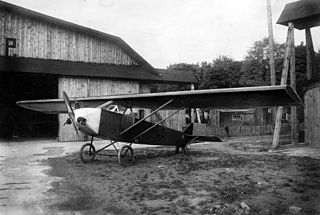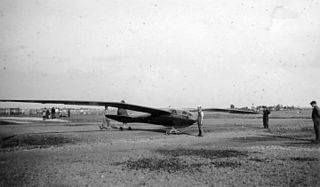The Dietrich-Gobiet DP.VII was a simple, low power, German sports aircraft flown in early 1924.

The Medwecki HL 2 was a Polish two seat lightplane flown in 1927. Handicapped by a low power, unreliable engine, its flying life lasted little more than a month.

The Offierski O.2 was a one-off, two seat, low powered lightplane built in Poland on the late 1920s. It flew in 1928 but an old and unreliable engine prevented its development.
The Medwecki and Nowakowski M.N.3 or just M.N.3 was a low-powered, four seat, Polish aircraft flown in 1928. The sole example was modified into a more powerful two-seater which served aeroclubs until World War II.

The Medwecki and Nowakowski M.N.5 was an economical Polish trainer aircraft initially aimed at the club market, though there was also some military interest. It performed well but lacked a constructor after Samolot became insolvent in 1930, so only one was completed.
The Gabriel P 6 was a Polish training aircraft and the P 7 a tourer. The difference between them was the wing configuration, chosen to optimise their speed range for their role, so the P 6 was a biplane and the P 7 a parasol wing aircraft.

The Silesia S-3 was the first design from the Polish Sopora brothers to fly. It was a low power, single seat, high wing light aircraft. Only one was built and its flying time was limited.
The Silesia S-4 was a Polish, low-power parasol wing aircraft built in 1925. After an engine change and airframe modifications it became one of the Silesian Aeroclubs fleet. It was lost in a take-off accident in 1931 and was the last Silesia aircraft to fly.

The Działowski D.K.D.1 was the first powered aircraft designed by Stanislaw Działowski. It was a low-power high-wing monoplane with a cabin for one passenger. After attending an aviation exhibition in Warsaw in 1927 it was badly damaged when the engine failed as it left and it did not fly again.
The D.K.D.3 was a Polish, single seat, parasol-wing sports aircraft first flown in 1927. Only one was built but flew in demonstrations and in national competitions into the early 1930s.

The Zalewski W.Z.XI Kogutek I was a basic, single seat sport aircraft designed and built in Poland in the 1920s. Its engine was also designed and built by Zalewski, making it the first all-Polish aircraft to fly.
The Grzmilas Orkan II was a Polish one-off, single-seat sports aircraft. It came second in the second National Lightplane Contest held soon after its first flight, with outstanding take-off and climb characteristics. Its designer and builder continued to use it until 1939.
The LKL IV and LKL V were a pair of very similar Polish parasol wing two-seaters, built in the early 1930s. They differed primarily in their engines.

The Sido S.1 was a Polish two seat, parasol wing trainer aircraft, first flown in 1930.

The Nowotny N-y 4bis was a tandem two-seat light aircraft, built in Poland, as a step towards a very light, low-powered training aircraft for flying clubs. Its designer was killed in a glider soon after the first flight of his trainer and its development was abandoned.

The Czerwiński CW 8 was a mid-1930s Polish open-frame basic training glider. Its design was advanced and its price low, but its stalling characteristics were too dangerous for beginners, so the thirty-plus examples completed were rapidly withdrawn from use. Two were subsequently modified, one with greater span and the other with a small engine.

The PWS-102 Rekin was a progressive development of the PWS-101, intended for cross-country flights. The prototype flew in an international contest in 1939 and the first of a projected production series was flown before the start of World War II.

The Czajka (transl. Lapwing) or Kocjan Czajka after its designer was a Polish secondary training glider which was in continuous production from 1931 to the start of World War II. More than 160 were completed in Warsztaty Szybowcowe in Warsaw.

The Warsztaty Szybowcowe Sroka, or Kocjan Sroka after its designer, was a Polish intermediate training glider. About sixty were built between 1934 and 1939.

The single-seat Kocjan Komar (Gnat) intermediate trainer, designed in 1932, was the leading and most produced sailplane in pre-war Poland. Production was resumed after World War II as the IS-B Komar and it remained in use until 1965.













